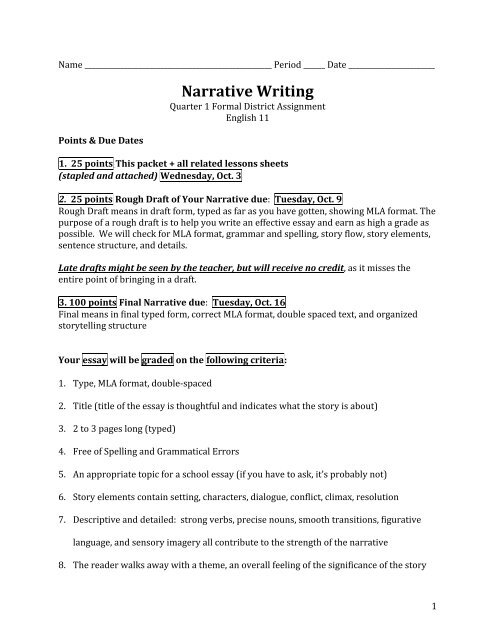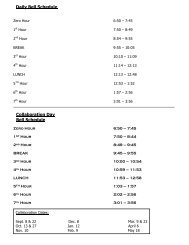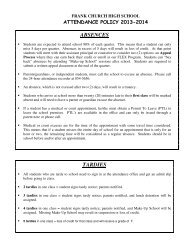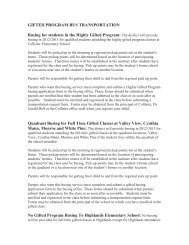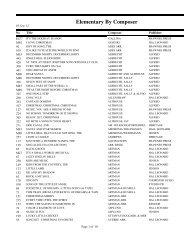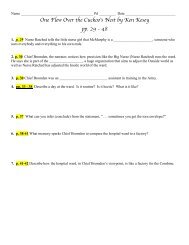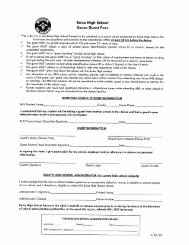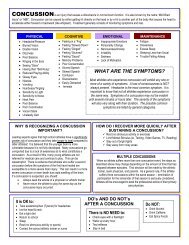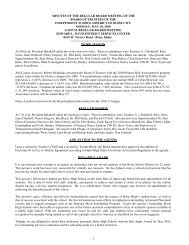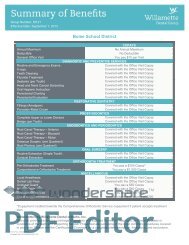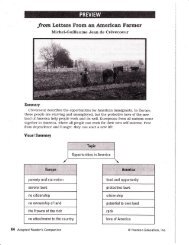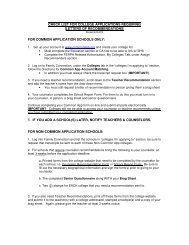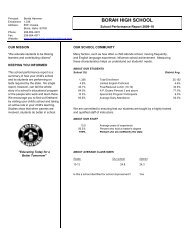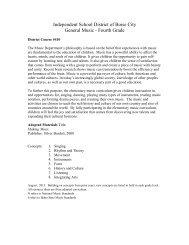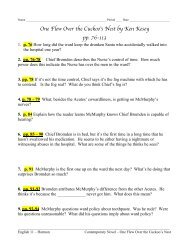Narrative Writing - Borah High School
Narrative Writing - Borah High School
Narrative Writing - Borah High School
Create successful ePaper yourself
Turn your PDF publications into a flip-book with our unique Google optimized e-Paper software.
Name ____________________________________________________ Period ______ Date ________________________ <br />
Points & Due Dates <br />
<strong>Narrative</strong> <strong>Writing</strong> <br />
Quarter 1 Formal District Assignment <br />
English 11 <br />
1. 25 points This packet + all related lessons sheets <br />
(stapled and attached) Wednesday, Oct. 3 <br />
2. 25 points Rough Draft of Your <strong>Narrative</strong> due: Tuesday, Oct. 9 <br />
Rough Draft means in draft form, typed as far as you have gotten, showing MLA format. The <br />
purpose of a rough draft is to help you write an effective essay and earn as high a grade as <br />
possible. We will check for MLA format, grammar and spelling, story flow, story elements, <br />
sentence structure, and details. <br />
Late drafts might be seen by the teacher, but will receive no credit, as it misses the <br />
entire point of bringing in a draft. <br />
3. 100 points Final <strong>Narrative</strong> due: Tuesday, Oct. 16 <br />
Final means in final typed form, correct MLA format, double spaced text, and organized <br />
storytelling structure <br />
Your essay will be graded on the following criteria: <br />
1. Type, MLA format, double-‐spaced <br />
2. Title (title of the essay is thoughtful and indicates what the story is about) <br />
3. 2 to 3 pages long (typed) <br />
4. Free of Spelling and Grammatical Errors <br />
5. An appropriate topic for a school essay (if you have to ask, it’s probably not) <br />
6. Story elements contain setting, characters, dialogue, conflict, climax, resolution <br />
7. Descriptive and detailed: strong verbs, precise nouns, smooth transitions, figurative <br />
language, and sensory imagery all contribute to the strength of the narrative <br />
8. The reader walks away with a theme, an overall feeling of the significance of the story <br />
<br />
1
As we’ve discovered, a narrative essay is about students writing their own stories <br />
• to pass on a culture’s history, beliefs, and values <br />
• to increase reading comprehension skills <br />
• to integrate and evaluate components of a story <br />
Nothing <br />
interesting <br />
to say ? <br />
So, are you one of my writers who thinks your life is dull? <br />
Nothing interesting has happened to you? Not true. <br />
Personal narratives are true stories based upon the experiences <br />
of the author. You may ask, “What is intriguing about me?” Well, <br />
people like to read true narratives because they can put <br />
themselves in the narrator’s position and actually experience the <br />
story. <br />
All personal narratives are written in the first person point of view. First person means <br />
using “I” as the narrator. If the narrative is written well, the reader may believe that he or <br />
she is “I” because the reader is thinking, “doing,” and feeling what the narrator of the story <br />
is thinking, doing, and feeling. <br />
In personal narratives, the reader wants to be invited to share in the story. If you are <br />
writing about a sad experience, the goal for you is to make your readers sad as well. If you <br />
are writing about a trip to Disneyland, your readers (who may have never been to <br />
Disneyland and may never have the opportunity to visit Disneyland) should be able to see <br />
Disneyland through your vivid descriptions and sensory imagery. <br />
1. Stop here: Let’s Brainstorm Topics <br />
Complete <br />
Lesson 7 “One Thing I’ll Always Remember” and <br />
Lesson 20 “Fast Forward” <br />
Narrow down a topic for your narrative. <br />
Topic 1 possibility _________________________________________________________________________________ <br />
Topic 2 possibility _________________________________________________________________________________ <br />
Topic 3 possibility _________________________________________________________________________________ <br />
You want to choose one of these to discuss in the rest of these instructions <br />
<br />
2
The beginning is the most essential part of the personal narrative. In the first paragraph, <br />
you have to grab your reader and make the reader want to read the story. <br />
2. Stop here: Let’s draft a setting for the story <br />
Complete <br />
Lesson 11 “Using Setting as a Springboard” <br />
Briefly describe the setting of your story <br />
Time _________________________________________________________________________________________________ <br />
Place _________________________________________________________________________________________________ <br />
Location ______________________________________________________________________________________________ <br />
The characters in your story must be true-‐to-‐life, and presented so the reader can see them. <br />
3. Stop here: Let’s develop some characters and dialogue for the story <br />
Complete <br />
Lesson 12 “Creating Characters “ <br />
Lesson 13 “Dialogue” <br />
List characters that will appear in your story <br />
________________________________ <br />
________________________________ <br />
________________________________ <br />
________________________________ <br />
________________________________ <br />
________________________________ <br />
________________________________ <br />
________________________________ <br />
Dialogue is a conversation between story characters. Write a star next to which <br />
characters might use dialogue in your narrative to reveal something about them or your <br />
story? <br />
<br />
3
Introducing the conflict is crucial. The reader will want to know how the characters deal <br />
with the conflict, so the experience of reading becomes not only enjoyable but also a <br />
learning experience. Readers will have the personal narrative to reflect upon if ever they <br />
find themselves in a similar circumstance or predicament. <br />
4. Stop here: Let’s define the plot & conflict of the story <br />
Complete <br />
Lesson 15 “Climax” <br />
Briefly chart the plot of your story. <br />
What is the conflict in the story? ___________________________________________________________________ <br />
_________________________________________________________________________________________________________ <br />
5. Personal narratives have themes that help the reader remember the narrative. <br />
Finishing the narrative, the reader will think—and come to his or her <br />
own understanding of the story. The theme may be somewhat different <br />
for the next reader, but what is important is that the narrative has given <br />
the readers something to take with them, to internalize, to process <br />
somewhere inside themselves. <br />
What is the theme you believe your narrative will convey (show)? _________________________ <br />
_________________________________________________________________________________________________________ <br />
<br />
4
What is the most important detail you learned about writing a narrative by completing this <br />
pre-‐writing packet? <br />
This writing packet was adapted by Mrs. Harmon from “Personal <strong>Narrative</strong>s,” #2994 <strong>Narrative</strong> <strong>Writing</strong>—Grades <br />
6-‐8, from Teacher Created Resources, Inc. <br />
<br />
5


